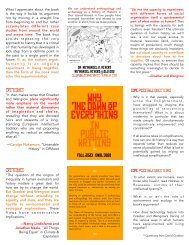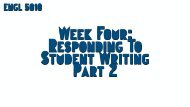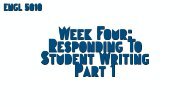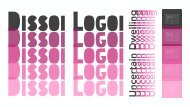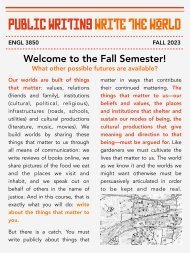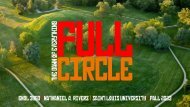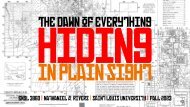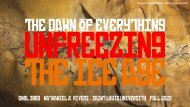ENGL 3860: Metaphysical Graffiti Slide Deck
ENGL 3860: Metaphysical Graffiti Slide Deck
ENGL 3860: Metaphysical Graffiti Slide Deck
Create successful ePaper yourself
Turn your PDF publications into a flip-book with our unique Google optimized e-Paper software.
P#UB$LICS@<br />
metaPhysical<br />
&#<br />
<strong>Graffiti</strong><br />
<strong>ENGL</strong> <strong>3860</strong> | Nathaniel A. Rivers | saint louis university | fall 2023
Publics are spheres that emerge<br />
and decay through the<br />
entanglement and circulatory<br />
coproduction of online and off-line<br />
networks.<br />
hawk | Public Spheres | 150
The public A public Discursive Publics Counterpublics<br />
The public, for Warner, is<br />
the imagined social totality<br />
of a nation or community<br />
that depends on rhetoric as<br />
transparent, rational, and<br />
deliberative; on institutionally<br />
sanctioned genre,<br />
speech acts, and speech<br />
s i t u a t i o n s ; a n d o n a<br />
hierarchy that counts some<br />
activities as public and<br />
others as private. As a result,<br />
certain dominant groups of<br />
people are more likely to<br />
stand in for the social<br />
totality as opposed to<br />
others (423). <br />
A public, in contrast, is<br />
a concrete audience<br />
g a t h e r e d a t a<br />
particular time and in<br />
a particular place<br />
whose boundaries are<br />
more or less distinct—<br />
an audience for a<br />
c o n c e r t , p l a y, o r<br />
political rally. <br />
Discursive publics only come<br />
into existence via the circulation<br />
of texts. A book, for example,<br />
isn’t bounded by space and time<br />
in the way that a public is, and its<br />
genre and circulation aren’t<br />
limited to the public. Instead they<br />
e x h i b i t s e v e n p r i m a r y<br />
characteristics: they are selforganized,<br />
a relation among<br />
strangers, both personal and<br />
impersonal, constituted through<br />
attention, c re a t e d b y t h e<br />
reflexive circulation of discourse,<br />
s t r u c t u r e d a c c o r d i n g t o<br />
temporality, and a product of<br />
poetic world making (413). <br />
Counterpublics are special<br />
cases of discursive publics that<br />
are marked by nondominant<br />
discursive practices. Because<br />
they don’t have access to the<br />
public and its forms and forums<br />
of speech, they run counter to<br />
dominant genres and modes of<br />
a d d re s s a n d o f t e n d o n ’t<br />
translate into the critical or<br />
rational models of the public.<br />
Instead, counterpublics might be<br />
hostile or indecorous like punk or<br />
might participate in the invention<br />
of their own discourses like<br />
queer counterculture. <br />
hawk | Public Spheres | 150
developing multiple alternatives to the public<br />
Following Warner more than Fraser, [Farmer] is interested in poetic world<br />
making and what this might mean for composition pedagogy. The<br />
emphasis on making and text circulation draws him to punk, anarchist, and<br />
riot grrrl zines as archetypal genres produced through acts of bricolage […]<br />
he develops the concept of bricolage as an artful making do. Percy, he<br />
notes, sees resistance occurring, “not in the forum, the streets, or the<br />
public square, but rather in the ad hoc, ingenuous, and quotidian<br />
strategies that individuals deploy in everyday contexts” (30).<br />
hawk | Public Spheres | 154
Zines are a perfect example of this phenomenon […] Very much into DIY<br />
aesthetics, they had random typography, hand-drawn images, and<br />
photocopied and stapled pages. And sans any official distribution, they were<br />
handed out to friends, left in record stores, and traded through the postal<br />
service. They were a celebration of the amateurish, makeshift, and the<br />
ephemeral, and their collage aesthetics and anticopyright ethos, especially<br />
among anarchist zines, outlined an alternative way to live and a form of<br />
micropolitics—a power at the capillaries to articulate the system differently<br />
with “whatever tools of textual circulation are readily available. This<br />
alternative poetic world, in short, must be built from the street up” (50). <br />
hawk | Public Spheres | 154
This ethos of “put on a show and see who shows up” is exhibited in zine<br />
culture as well—make a zine, randomly circulate it, and see who is hailed by<br />
it and decides to show up for a gig, start their own band, or make their own<br />
zine […] Making zines in composition classes also gives students more<br />
rhetorical options than learning dominant argumentative or reasoned<br />
discourse. It gives them more rhetorical options in relation to the types<br />
of publics they may want or need to address and bring into being. It<br />
gives students an alternate vision of democratic discourse, a different sense<br />
of publicness, and a different form of citizenship grounded in making<br />
publics.<br />
hawk | Public Spheres | 155
Roman <strong>Graffiti</strong> from Pompeii, c. 70 B.C.E<br />
I'm amazed, oh wall, that you haven't fallen into ruins<br />
since you hold the boring scribbles of so many writers.
As I thought more about this scene, I began to<br />
hear echoes of my own relentless pedagogical<br />
question to students: What is this writing doing?<br />
I felt myself punctuated by those giant letters and<br />
excessive (punctuation) marks. It really got under<br />
my skin.<br />
Edbauer | (meta)Physical <strong>Graffiti</strong> | 132
Yet, what Trimbur’s model does not explicitly<br />
address, and what the ZEPPELIN example makes<br />
painfully clear, is that writing scenes are <br />
overwhelmingly populated by bodies: shocked,<br />
angry, delighted, and feeling-full bodies.<br />
Edbauer | (meta)Physical <strong>Graffiti</strong> | 133
Because the body-of-sensation is always<br />
stubbornly present in scenes of writing, there can<br />
be no affectless compositions. In order to more<br />
fully answer the question of what writing does,<br />
therefore, we need a model that takes affect’s<br />
operations into account.<br />
Edbauer | (meta)Physical <strong>Graffiti</strong> | 133
Using graffiti as an unruly exemplar, I read <br />
three familiar topoi—context, style, and signification<br />
—across scenes of graffiti in order to explore writing’s<br />
affective dimensions that are often neglected in<br />
composition […] More specifically, I argue that<br />
rhetoricity itself operates through an active<br />
mutuality between signification and affect.<br />
Edbauer | (meta)Physical <strong>Graffiti</strong> | 134
In short, we should consider the sensational<br />
experience of the body-in-context. Even before<br />
we have the opportunity to generate a discursive<br />
response to a situation, the body-in-context is<br />
first viscerally involved.<br />
Edbauer | (meta)Physical <strong>Graffiti</strong> | 139
S@OME# SPINOZA@<br />
This primacy of affective involvement has perhaps been most thoroughly<br />
explained in the philosophy of Spinoza and his interest in the sensing body.<br />
Spinoza explicates something he calls the affections of the body, where “the<br />
body’s power of activity is increased or diminished, assisted or checked . . .”<br />
(104). For Spinoza, a body is never a/lone(ly) body, for one body is always in<br />
relation to another. “The human body can be affected in many ways by which its<br />
power of activity is increased or diminished," writes Spinoza (104). The relation of<br />
affect is not a one-way proposition. A body is affected by another body as much<br />
as it affects another body. His sensing body is a body-in-relation.<br />
Edbauer | (meta)Physical <strong>Graffiti</strong> | 141-42
You get down and immediately “lose yourself” in the<br />
music. Clichéd as it may be, this phrase bears out a<br />
kind of truth, for we do indeed lose our selves as<br />
delimited spaces. We lose our selves as an enclosedbordered<br />
subject. The music moves you, in spite of<br />
your wishes or desires.<br />
Edbauer | (meta)Physical <strong>Graffiti</strong> | 142
The sensation of such a relation, moreover, is what we might<br />
call the encounter of affect. It is the experience generated by<br />
relations—by your body-in-relation. We find that the<br />
rhetorical context that “calls” writing into being is always first<br />
a scene of affect’s experience. This is the primary cull to<br />
writing, which marks a relay between rhetorical context and<br />
the affective body.<br />
Edbauer | (meta)Physical <strong>Graffiti</strong> | 142
To create a strong ethos, therefore, the writer counts on an<br />
aggregate of sensation. The writer’s ability to create “impact”<br />
depends upon the feeling of too much or more than normal, or<br />
an experience of something got around. In other words, the<br />
writer depends on something else existing in proximity to<br />
signification and discursivity. Being spotted—getting up in as<br />
many different places as possible—is the only way to build<br />
ethos as a writer.<br />
Edbauer | (meta)Physical <strong>Graffiti</strong> | 144
Style is that which opens sites for making something<br />
matter to people—giving it a hook, a feel, a space to<br />
invest certain kinds of interest. Borrowing from<br />
Grossberg, we can argue that a “working” style is one<br />
that generates aggregate sensations of excess, all of<br />
which cull attention, interest, and affective investment.<br />
Edbauer | (meta)Physical <strong>Graffiti</strong> | 146
Sign|SY#MBOL<br />
hermeneutics|HE$URISTICS#<br />
Signification|ASIGNIF$ICATION@<br />
representation|N$ONREPRE$SENTATI#ON
A writing’s impact may not have the same effect as its<br />
meaning effects. The two exist in proximity to one<br />
another in the space of rhetoric. Very much like a pun, or<br />
even the buffoonery and useless expenditure of two giant<br />
yellow words reading ZEPPELIN ROCKS!!!, writing is<br />
comprised of impacts that are at once intense and im/<br />
palpable.<br />
Edbauer | (meta)Physical <strong>Graffiti</strong> | 151
structure<br />
Of Feeling<br />
R#AYMOND# W$ILLIAMS<br />
P$REFACE TO FILM ($1954)
Style is more than the genre, voice, and look of<br />
writing; it is also an aggregate of sensation. Style is<br />
an active and directive pulling—it draws various<br />
degrees of investment into particular sites.<br />
Edbauer | (meta)Physical <strong>Graffiti</strong> | 154
These are rhetoric’s domains of effects that<br />
construct the experience of daily life. The<br />
“practical” aspect of writing and rhetoric (for<br />
better or worse) is therefore nothing other than<br />
affect at work.<br />
Edbauer | (meta)Physical <strong>Graffiti</strong> | 154-55





